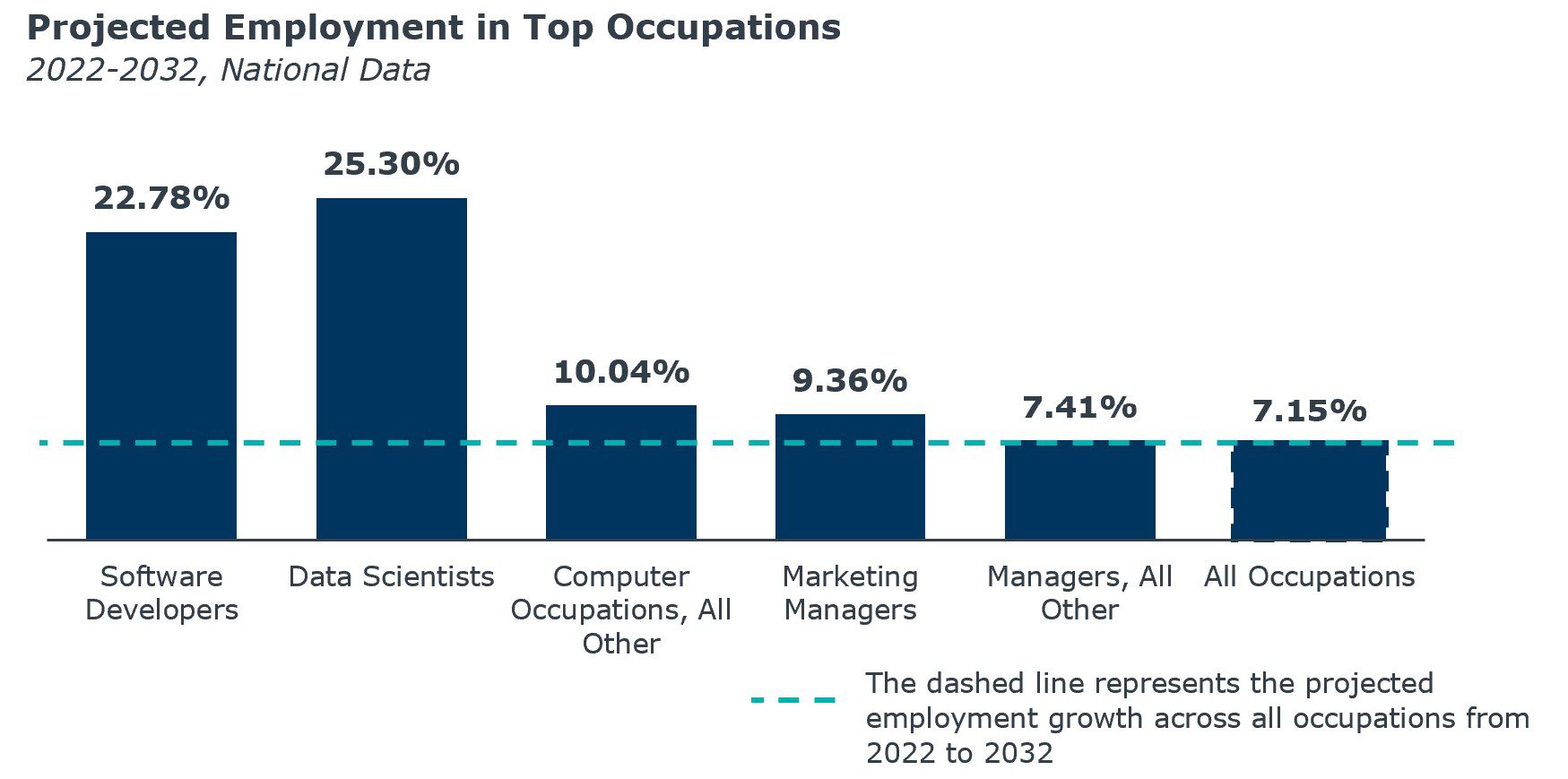Considering launching a data analytics program? Here’s what you need to know
Demand for data analytics professionals has skyrocketed in recent years and should only continue to grow. Job postings for data analytics professionals across all degree levels have more than doubled from July 2019 to June 2022.
While many university leaders are interested in launching data analytics degrees, designing data science programs is particularly challenging. Data professionals must prepare to work in a number of distinct fields, and programs must keep up with ever-changing advances in the field. My team and I analyzed 5 years of job postings and competitive landscape data as well as employment projections to identify:
- The market for data analytics programs and
- What successful data analytics programs need to attract students, with a particular emphasis on adult learners.
-
+121
Growth in bachelor’s-level data analytics job postings per month, July 2019 to June 2022.
Employer and student demand for data analytics is growing rapidly—but so is competition
National employer demand rose rapidly (approximately 2.5% per month) for data analytics professionals with bachelor’s and master’s degrees, which outpaces all job postings’ growth overall. The current data analytics labor market looks promising, and labor experts anticipate even further growth. As depicted in the chart below, employment projections show top data analytics professions will increase faster than overall employment through the next decade.

Given adult learners are highly motivated by education’s career impact, rising student interest in data analytics programs is unsurprising based on current and projected job market data alone. For example, related bachelor’s degree completions have grown 25.11% in the last five years.
ONE INSTITUTION LAUNCHED A DATA ANALYTICS PROGRAM AND GREW ENROLLMENT BY 24%
As student demand grows, so has the number of institutions entering this market. Programs must differentiate themselves from competitors and larger bachelor’s and master’s programs, which tend to take up a disproportionate share of the market. The three programs highlighted below provide helpful examples of standing out in this crowded market.
-
Southern New Hampshire University
SNHU’s B.S. Data Science program does not require essays, letters of recommendation, or test scores in their admissions materials. Minimizing application barriers welcomes adult learners who may have extended gaps in education.
-
New York University
NYU’s M.S. in Data Science program offers summer research initiatives where students engage with campus research labs and industry partners. This extensive experiential learning option helps students apply skills and enhance their networks.
-
Colorado State University
Colorado State’s Data Analytics Graduate Badge offers rare elective coursework relating to environmental data analysis. Specialized coursework helps align students with their preferred career field.
Ensure curriculum teaches in-demand programming and business management skills
The skills demanded of data analytics professions differ by degree level requested; jobs requiring more advanced education tend to seek more complex programming skills as well as further business management skills (i.e., project management and finance). While expected skills like computer science and other data analysis skills are in demand, business skills such as “marketing,” “accounting,” “process management,” and “business intelligence” are also surprisingly common across all levels. Ensuring graduates complete coursework like “Business Fundamentals for Analytics” (Georgia Tech) and “Business Intelligence and Data Analytics” (University of Maryland Global Campus) helps prepare graduates for in-demand jobs. Southern New Hampshire University even went as far as including a concentration option in “Project Management for STEM” in their bachelor’s program.
ARE YOUR GRAD AND ADULT-SERVING PROGRAMS OPTIMIZED FOR ENROLLMENT GROWTH?
Identifying skill gaps across different degree levels guarantees program curriculum aligns well with in-demand skills, which will transfer well into varying occupations. For example, non-degree programs maintain coursework that applies programming language skills like “SQL,” “C,” Python,” and “R,” which are more in-demand than previously common programming language, SAS. Confirming program curriculum stays up to date with technical skills and the emerging landscape of data analytics will help programs adequately prepare program graduates.
Top skills sought in relevant job postings
Bachelor’s-level job postings
- “Computer Science”
- “Python”
- “Data Management”
- “SQL”
- “Java”
Master’s-level job postings
- “Python”
- “Computer Science”
- “Machine Learning”
- Data Science”
- “Statistics”
Is a data analytics program right for your institution?
While this blog post offers insight into the national landscape of data analytics programs, professional and continuing education leaders must consider additional factors such as local and regional implications that may offer more specific insight on their programs’ feasibility. Data analytics curricula also require significant computer science coursework at all levels as noted above, so launching a successful program without existing knowledge or comparable programs may prove especially challenging at less STEM-focused institutions. Nevertheless, data analytics programs overall help align graduates with a promising career path in an emerging and advancing field with increasing employment opportunities.
More Blogs

4 questions domestic students will ask before applying to your graduate program

When Grad PLUS disappears: What 8,000+ grad students said about paying for school
